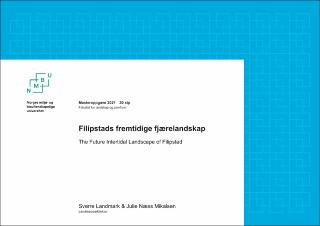| dc.contributor.advisor | Husaas, Ellen Merete | |
| dc.contributor.author | Landmark, Sverre | |
| dc.contributor.author | Mikalsen, Julie Næss | |
| dc.coverage.spatial | Norway, Oslo | en_US |
| dc.date.accessioned | 2022-03-14T11:41:03Z | |
| dc.date.available | 2022-03-14T11:41:03Z | |
| dc.date.issued | 2021 | |
| dc.identifier.uri | https://hdl.handle.net/11250/2985057 | |
| dc.description.abstract | Denne masteroppgaven er en mulighetsstudie, med mål om å undersøke hvordan Filipstads nye møte mellom land og vann kan utformes. Mulighetsstudien viser hvordan en naturrestaurering av Filipstads strandsone og park kan gi Filipstad et større biologisk mangfold, unike kvaliteter og rekreasjonsområder. Vi belyser hvordan restaurering av naturverdier bør være en sentral del av byutvikling ved fjorden, og oppgaven er dermed et bidrag inn i Filipstads stedsutviklingsprosess og den generelle debatten tilknyttet byutvikling i og ved urbane sjøområder.
Det industripregede kaiområdet på Filipstad vest i Oslo skal i de neste tiårene gjennom en omfattende byutvikling. Byutviklingsområdet som utgjør Filipstad, har et areal på ca. 320 dekar – eller 45 fotballbaner. Filipstads områderegulering fra 2020 åpner for et nytt bystrøk, med 2000-3000 boenheter, flere næringsbygg, veier, gater, byrom og parkområder. Med denne byutviklingen vil hele landskapet omdannes, blant annet som følge av større utfyllinger av masser, og etablering av ny infrastruktur, bygningsmasser og andre strukturer. Byutviklingen vil dermed påvirke områdets 1600 meter lange kystlinje og fjæresone. Denne kystlinjen møter en indre Oslofjord som er under et økologisk og arealbruksmessig press.
Oppgavens stiller spørsmålet: Hvordan kan Filipstads nye fjærelandskap utformes på en måte som fremmer et marint biomangfold, og samtidig være et rekreasjonsområde for mennesker? Med fjærelandskapet, mener vi landskapet som befinner seg i overgangen mellom land og vann, med dets innbyggere og naboer av levende planter, dyr og mennesker. Dagens områderegulering tar utgangspunkt i konvensjonelle urbane sjøfronter og strukturer i sjø, og inkluderer utenriksfergeterminal på Hjortneskaia. Vår mulighetsstudie er et alternativ til områdereguleringen, hvor vi presenterer et planforslag for en flerartslig utforming av en ny, tilgjengelig strandsone og sjønær park.
Oppgaven er bygget opp av fem kapitler. I det første kapittelet introduseres oppgavens tema, problemstilling og mål. Her presenteres også oppgavens bakgrunn, metode, avgrensning og oppbygning. Videre presenteres Filipstad mer utfyllende, gjennom et utvalg relevante planfaglige føringer, registreringer og analyser. I kapittel tre sammenfatter vi relevant faglig bakgrunn og kunnskap om marin naturrestaurering.
Videre presenterer vi et planforslag – et helhetlig forslag for Filipstads fremtidige fjærelandskap. Planforslaget bygger på seks overordnede designprinsipper, basert på funn fra de foregående kapitlene. Planforslaget presenteres gjennom en hovedplan og tre delområder. Oppgaven avsluttes med en refleksjon og konklusjon. Her drøfter vi vårt eget planforslag, fremtidig byutvikling ved sjøen og potensielle økologiske scenarioer. | en_US |
| dc.description.abstract | This master’s thesis is a feasibility study aspiring to investigate the design approach at Filipstad where land and sea meet. The study shows how a natural restoration of the park and coastline at Filipstad is capable of providing greater biological diversity, unique qualities, and recreational spaces. We exemplify how the restoration of natural values should be essential in urban shoreline development, making this study serve as a contribution to both the process of the development of Filipstad as well as the overarching urban marine development discourse.
Today’s industrial waterfront lot at Filipstad in western Oslo is set to go through a comprehensive urban transformation. The development site that is Filipstad encompasses an area of about 70 acres – or 53 football fields. The area zoning plan of 2020 stipulates a new part of town with 2000-3000 housing units, multiple commercial buildings, roads, streets, urban spaces, and parks. As this development proceeds, the whole landscape will be transformed, for instance through mass hauls and the installation of new infrastructure, edifices, and other structures. Subsequently, the development will affect a total of 1750 yards of dry and littoral coastline. This coastline borders the inner parts of the Oslofjord, a waterbody under ecological and landuse strain.
The study poses the following question: How can the new intertidal landscape at Filipstad be designed in a way that promotes marine biodiversity whilst simultaneously serving as a recreational space for people? The term intertidal landscape denotes the landscape located between high and low tide, including its inhabitants and neighbors of living plants, animals, and people. Today’s zoning plan assumes a conventional urban shoreline and marine structures, and it includes an international ferry landing at Hjortneskaia. Our feasibility study is an alternative to the current zoning plan in which we present a planning proposal for a multispecies design of a new accessible coastline and waterfront park.
The study consists of five chapters. The first chapter introduces the topic, the research question, and the purpose of this study. It also presents background information, the method, the delimitation, and overall structure. In the next chapter, Filipstad is presented more extensively through a selection of pertinent planning policies, site inventories, and site analyses. In chapter three, we compile relevant technical knowledge as it pertains to marine natural restoration.
Further, a holistic planning proposal will be presented for Filipstad’s future intertidal landscape. The proposal is attributed to six underlying principles of design that are based on findings in the previous chapters. The proposal is presented through a master plan with three sub-areas in more detail. Through reflection, the study arrives at a conclusion. In this part, we discuss our final planning proposal, future coastal urban development, and potential ecological scenarios. | en_US |
| dc.language.iso | nob | en_US |
| dc.publisher | Norwegian University of Life Sciences, Ås | en_US |
| dc.rights | Attribution-NonCommercial-NoDerivatives 4.0 Internasjonal | * |
| dc.rights.uri | http://creativecommons.org/licenses/by-nc-nd/4.0/deed.no | * |
| dc.title | Filipstads fremtidige fjærelandskap | en_US |
| dc.title.alternative | The future intertidal landscape of Filipstad | en_US |
| dc.type | Master thesis | en_US |
| dc.description.localcode | M-LA | en_US |

